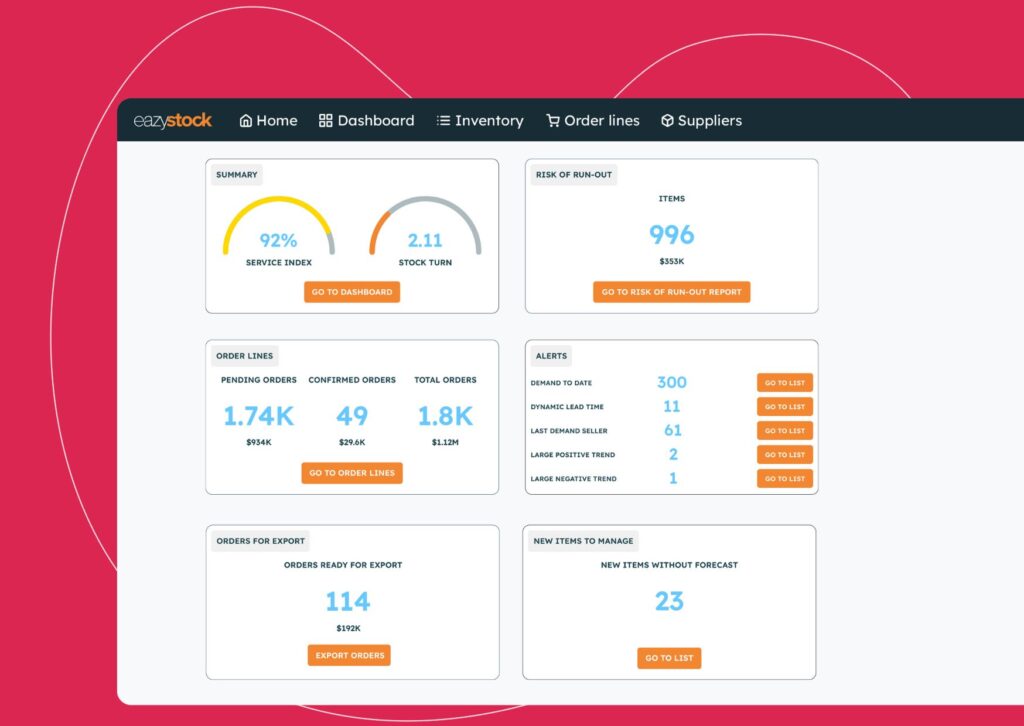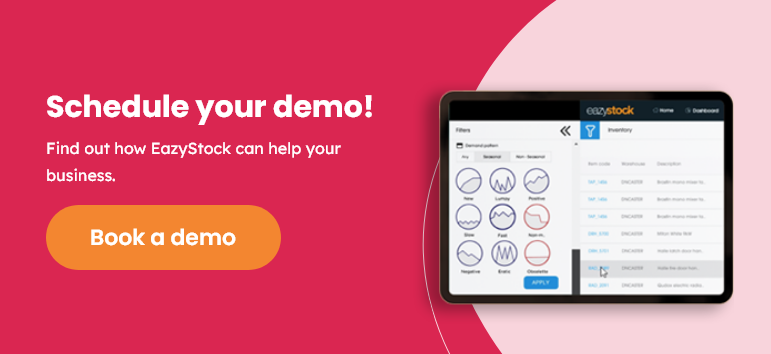A review of Business Central’s inventory planning and reordering policies
As a busy inventory manager, if you’re using your enterprise resource planning system (ERP) for planning and reordering, you’re probably struggling to keep on top of your inventory.
Even the most sophisticated ERP systems can be a source of frustration for inventory managers. The reliance on manual input and spreadsheets to set reordering parameters, along with the subsequent need to manually input the information back into the system for purchasing decisions, can be time-consuming and tedious.

Unfortunately, Microsoft Dynamics 365 Business Central is no different. While the market-leading ERP for small and mid-sized companies arguably has more advanced reordering capabilities, users still have to do a lot of manual calculations.
In this post, we examine the inventory ordering functionality in Microsoft Dynamics 365 Business Central and explain how EazyStock can deliver additional capabilities.
EazyStock is an established inventory optimization app available in Microsoft AppSource. With our ready-made connector, it’s easier than ever to integrate EazyStock with Business Central to provide advanced inventory management capabilities.
Microsoft Dynamics 365 Business Central’s reordering policies
In Dynamics 365 Business Central’s inventory management module, users can manually enter a range of planning parameters for every stock item. These include reorder points, safety stock lead times, safety stock quantities, time buckets (reorder cycles), and order modifiers, e.g. min/max order quantities or order multiples.
You can then assign one of four reordering policies: Fixed Reorder Quantity, Maximum Quantity, Lot-For-Lot, and Order.

Your chosen reordering policy determines how the individual planning parameters interact and how the ERP calculates when and how much to reorder. Using this pre-programmed logic, Business Central produces reorder proposals when replenishment is necessary.
While this functionality is more advanced than many ERPs, it still has several crucial drawbacks:
- It’s time-consuming to set up; you need to calculate all planning parameters outside of Business Central and port them back in.
- It relies on you knowing which reordering policy best suits every stock item.
- Some reordering policies depend on manual demand forecasts; some don’t even use forecasts.
- Every planning parameter and reordering policy is static and has to be manually adjusted.
- It relies on lead times remaining static.
- Planning parameters are interlinked. For example, safety stock is dependent on lead times and demand volatility. Min/max order quantities can affect reorder points and quantities. This means that when one parameter requires adjustment, they all might.
The lack of automation in allocating reordering policies and planning parameters makes replenishment a very time-consuming and manual process for the user. Plus, most markets experience fluctuating demand and supply variables. This means these policies and parameters need to be regularly revised to prevent reordering resulting in episodes of excess (even obsolete) inventory or stockouts.
Automated reordering and replenishment
A key benefit of using EazyStock is that it eliminates the need for manual work and deliberation over choosing the right replenishment strategies and rules.
EazyStock calculates all reordering policies and automatically adjusts them to changes in demand forecasts, stocking rules, target service levels, and supplier lead times. This means reordering becomes market-led and reacts to customer behavior (or production requirements) and supplier performance.
Let’s look at some examples of EazyStock’s replenishment functionality:
Safety stock
Most inventory planners manually calculate safety stock quantities by taking the cycle stock quantity over a specified period and adding a little more, just in case.
Instead, EazyStock uses statistical algorithms to consider important factors, such as service level, forecast accuracy, and lead time variability. Since each inventory item has a unique demand pattern, it adjusts safety stock levels accordingly.
Reorder alerts
In Business Central, reorder points are either fixed or based on a static forecast, both of which are manually calculated.
In contrast, EazyStock automatically considers dynamic demand forecasts (so ordering mirrors customer demand), safety stock levels (to avoid stockouts), and supplier lead times (to cover supplier holidays or busy periods).

If ordering or delivery acceptance can only take place on specific days of the week or month, you can add these operational constraints to EazyStock’s order calendar feature. The system then recalculates reorder quantities, safety stock levels, and reorder dates to prevent any impact on stock availability.
Reorder quantities
In Business Central, reorder quantities are either fixed (using the Fixed Reorder Quantity reordering policy), vary to hit a specified max/min capacity (Maximum Order Quantity), or are accumulated based on a demand forecast (Lot-For-Lot).
All options have the potential to result in stockouts or excess stock. For example, as fixed or maximum order quantities are static, they fail to account for market dynamics. As the Lot-For-Lot strategy relies on a manual forecast, it places the order when the first demand is needed. Unless the lot accumulation period is relatively short, items could be held in the warehouse for unnecessarily long periods.
Instead, EazyStock automatically generates daily order proposals that base order quantity calculations on current stock levels, reserved stock, goods-in-transit and back-orders, dynamic demand forecasts, and stocking rules, as well as planning parameters, e.g. safety stock, min/max order quantities. This ensures the optimal reorder quantity is always suggested.
Lead times
EazyStock’s dynamic lead time feature helps mitigate the impact of supply delays on fulfillment by tracking actual lead times and sending alerts when they begin to deviate from the norm. Users can then either manually adjust planning parameters for the affected items or let the system update them automatically.
Smart and efficient reordering
EazyStock forecasts demand and classifies inventory before assigning stocking policies to each stock item. The system then continuously analyzes items to ensure each one falls into the correct demand type and the appropriate area of its inventory matrix. This ensures it’s subject to the correct stocking rules, and the replenishment parameters are adjusted accordingly.
With these advanced algorithms working in the background, EazyStock provides a daily list of items and their optimal reorder quantities. Users can then either review the orders (which they may do for high-priority, slow-moving items) or automate the ordering process (which often happens with faster-moving, low-value items where the risk of excess stock is low). The orders can then be imported back into Business Central for processing.
Finally, by reviewing EazyStock’s user-friendly dashboard daily, users can sense-check their replenishment recommendations. The system promotes managing by exception, providing inventory alert reports so attention can be given to product categories or even SKUs that need revision or fine-tuning from a human perspective.
This results in more efficient day-to-day replenishment tasks, with reordering that considers demand and supply variability and prevents over-stocking.
Supply chains are more complex than ever, with inventory management teams spinning many plates, dealing with erratic demand and unpredictable supplier lead times. The less time spent on stock calculations, the better. With EazyStock, planners can save valuable time and resources by automating forecasting and replenishment calculations. With a wealth of accurate and drillable data on hand, they can also make better, data-driven purchasing decisions, making them more responsive to demand or supply changes.
If you’d like to know more about how EazyStock can support your inventory management operations, please get in touch with our team today.









